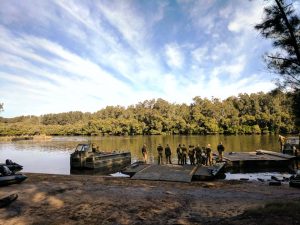'It is truly like a radioactive half-life: there is a steady decay, but there is always a little residual available to tap into. However, as long as warriors can refresh their skill… it will be there when needed'.
On Combat: The Psychology and Physiology of Deadly Conflict in War and in Peace by David Grossman
Overview
The professional soldier must master numerous small skills to be ready for combat. However, proficiency in these skills diminishes over time. Accordingly, soldiers need a framework to ensure they achieve permanence in the small skills needed for combat. This framework should have two parts: first, small skills should be taught via a ‘core’ course and, as required, a ‘top up’ course; and second, Army should recognise individual ‘masters’ as subject matter experts (SMEs) for each small skill. Parts of this framework already exist; they now must be formalised.

What are 'small skills'?
Professional soldiers are the sum of their experiences and training. This training can be broken down into many ‘small skills’—skills learned over a day or two. Small skills are diverse, they can include: weapon competencies, airborne rappelling, operating basic machinery, building combat bridges, employing radio equipment, and operating Army’s Battle Management System. After formal instruction in these small skills, the professional soldier is competent. However, competence can only be maintained through regular practice.
Core courses and top up courses
The current framework for teaching small skills is not optimal. Consider a soldier who is taught how to use a personal radio: at the completion of the training they are deemed competent; however, if they are not required to operate it during a posting cycle, they may forget this small skill. There is no framework that accounts for this or remediates soldiers’ small skill deficiencies before these skills must be used; they are left to themselves to relearn.
One way to fix this would be to teach small skills in two parts. Initially, a 'core' course would make a soldier competent. Then, a 'top up' course could be delivered to maintain that competence. Core training is resource intensive - expending ammunition, using specialised equipment or even helicopter flight hours. However, these resources are not always required to top up the diminishing small skill competence. A less resource-intensive alternative, such as classroom theory, may be sufficient to maintain a professional soldier’s neural pathways. More, in the technology-enabled Army, blended learning provides an ideal platform to deliver top up training.

Training establishments and combat brigades
Training establishments should teach core small skills, while the battalions and regiments should maintain and top up this training. Battalions are hard-pressed to provide comprehensive individual training and also ensure competency is maintained. Training drivers, Battle Management System skills and specialist weapon qualifications - just to name a few - must not be a burden for battalions. This proposed framework would see individuals ready to commence ‘force generation’ activities upon completion of employment training (a much more resource-intensive job) and then topped up to maintain competency in small skills relevant to their battalion.
Formalising the division of training responsibilities would bring clarity to decisions affecting resource allocation and management. Training establishments and battalions will be optimally resourced to meet their respective priorities; this is yet to occur across all training establishments. For example, training drivers to operate in a combat environment requires an awareness of working with dismounted soldiers—vehicular awareness skills. Currently this training may be forgone in some training establishments due to the perception that soldiers can receive it within a brigade. To rectify this, training establishments should prioritise simulation facilities and external support to more aptly match the equipment and platforms in our brigades. This will reduce the burden on battalions that have created a disproportionate staffing to cover this policy gap.
Investing in masters
To optimally develop and maintain small skills competency, Army should leverage the SME knowledge inherent within the wider Army. Battalions already hold individuals designated as ‘masters’ for some skills, like the Sniper Master in the standard infantry battalion. This part would see individuals singled out to hold an extra-regimental appointment to act as a SME of a particular small skill in addition to their job role responsibilities. This should occur for all small skills.
Delegating SME responsibilities would also empower and enthuse professional soldiers to promote proficiency, and to contribute their expertise to Army’s Body of Knowledge. Each individual SME could be linked to a network of SME professionals attuned to developments in tactics, techniques and procedures (TTPs). This SME network would extend across Army to support top up training and feed into core training development.
Decentralised ownership of small skills, enabled by technology, advances the Army’s small skills development. Army doctrine currently requires a small centralised group to contribute knowledge and to then consult widely before releasing updates. An established SME network could facilitate collaboration to develop knowledge and also provide update approval. It would also enable innovations in TTPs to spring from frontline SME practitioners.
Conclusion
Army’s desired outcome for individual small skills is not formalised. Achieving permanence in small skills requires two parts: establishing a core and top up system for training, and creating a network of masters. These two parts will provide the foundation for Army’s professional soldiers to master numerous small skills and be prepared for future challenges.










Finally, your comments referring to the contribution to developing doctrine is paramount in the maintenance of standards. During the last few years, particularly post the introduction of Dismounted Minor Tactics and the Patrolling Pam, I often hear the term 'open to interpretation'. The development of doctrine needs to cater for the development of junior soldiers and officers whilst setting a standard for those implementing tactics on the battlefield. Therefore, as suggested, SME networking and the ongoing pursuit of developing clear, concise and detailed doctrine is needed to support permanence.